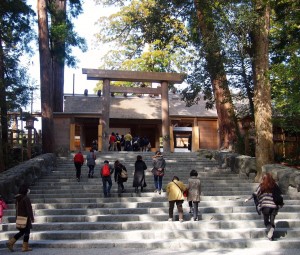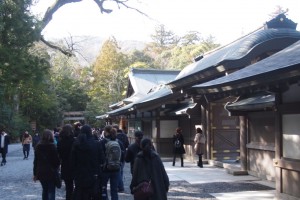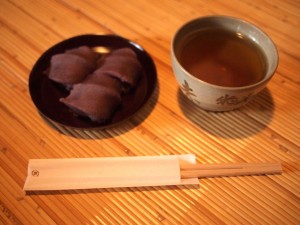Learning about Ise at Kogakkan: Days 3 and 4
The past two days have been focused on two things: a guided tour of Ise Jingū, and an overview of Ise society focusing on the early modern period. Our professor for these two days, Sakurai Haruo, introduced us to a lot of fascinating things about life around the Jingū in the early modern period. Ise was Japan’s biggest attraction, home to the country’s first paper money, first environmental protection policy, community libraries, souvenirs, and coupon books.
Originally, Ise only had one pilgrim: the saioh 斎王, a female Imperial relative who lived in a house called the saikū 斎宮. As the ages passed, eventually other kinds of attendants were allowed in, then Buddhists, then the general public. By the Edo period, Ise was being marketed throughout the country by professional promoters called oshi 御師, which means “great teacher,” but tellingly is a homonym for “pusher” [this is incorrect. For details see this post].
Ise became big as a place to get away to. Sakurai-sensei showed us a memorial to a teahouse in Osaka where people would gather to form groups and start on the road to Ise. In fact, it was not just those from out of town but also those in Osaka who would gather here, in order to get away from their families before starting the trip. In the Edo period, apparently, people from all walks of life desired a break from the everyday, and trying to improve their lives and connect with the heart of the nation at the Jingū was the popular way to achieve this.
Runaways were often punished, but this was rarely severe. It seems to be akin to the modern day situation of a teenager grabbing Mom’s car and going for a joyride, except that in this case the runaways could claim they had important reasons to go to the Jingū, and could take a month or two to return. The attitude of shrinekeepers towards the pilgrims and the trials they expected them to face on return is worth noting, as translated in an excellent article by Laura Nenzi in the Japanese J of Religious Studies.
A collection of miraculous tales associated with the Ise pilgrimage of 1705, Ise daijingū zoku shin’iki 伊勢太神宮続神異記 [Records of the miracles by the gods of Ise Shrine, a sequel] includes episodes that well illustrate how frosty, if not downright hostile, the reception of returning fugitives could in fact be. One such episode narrates the story of a female servant from a household in Settsu 摂津 Province who sets out for Ise without notifying her master. Enraged, the master’s wife accuses the servant of having committed “a punishable act” (kusegoto 曲事), and vows to reprimand her accordingly. When the servant comes back, she brings amulets and souvenirs, and reassures her masters that she prayed for them at the shrine. Utterly unimpressed, the two kick the amulet box across the room and punch her. Out of the amulet box comes a small snake that rapidly grows in size to horrifying monster-like proportions. Terrified by the supernatural occurrence, husband and wife forgive the servant, beg for mercy, recant their faith in the Lotus Sutra, and vow to go to Ise to expiate their sins. […]
Collected by members of the Ise clergy (hence the reference to recanting the faith in the Lotus Sutra), these tales inevitably end with the triumph of the kami and of religious logic, effectively serving as propaganda for the claim that faith ought to exist above and beyond the practical needs and the laws of “this” world, and would have its ways in the end.
But notice also the concern the Jingū shrinekeepers had for a lowly servant. Such a class of person could not be expected to bring a financial windfall to the Jingū. What concerned them more than economic benefits was ensuring that trips to Ise would be taken seriously and respected as an act of devotion.
Pilgrims carried a ladle to show that they were accepting donations, but for unknown reasons they would discard it when they reached the Naikū. Mothers often came carrying their children, and if they were separated, the monks of Ise would take care of the kids until they were reunited. It was a crowded place, especially in years of okagemairi when millions of people suddenly descended on Ise en masse, and rarely would visitors stay for more than 2 or 3 days. But they might go on to some other, less sacred destination before returning home.
Our tour was led over the past two days by Sano-san, who I posted a picture of on Day 1. He gave us all the stats on every major shrine inside the Jingū grounds. The guy really is a walking database. As always, Kogakkan paid for the tour and gave us free Akafuku, the famous Ise treat. I hadn’t had it before and it was delicious!
Today, visitors to Ise get an even more splendid sight than the pilgrims of the Edo period: streets full of well-maintained, beautiful old houses, called Oharai-machi around the Naikū and Iseshiekimae around the Gekū. The restoration of these streets, which took place respectively around the 1993 and 2013 shikinen sengū, cost the city over $400 million. But the attention to detail shows, for example when you look at this unusual convenience store entrance.
These days, though, the Japanese approach to religion is changing. After the Aum Shinrikyo subway bombings especially, many Japanese people feel “allergic” to religious adherence, but they still want a connection to an unseen “something” outside themselves. As a result, pilgrimage to Ise has skyrocketed, and random spots inside the shrine are now becoming “power spots” where people try to feel some magical energy radiating out. Sakurai-sensei said there has not been a lot of work done in this field yet, but this is something I hope to look into during my own research program in Tokyo.
Posted: February 26th, 2015 | Kogakkan




